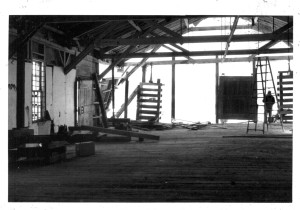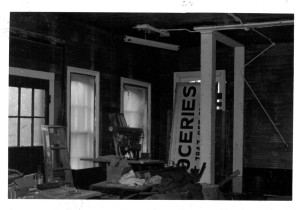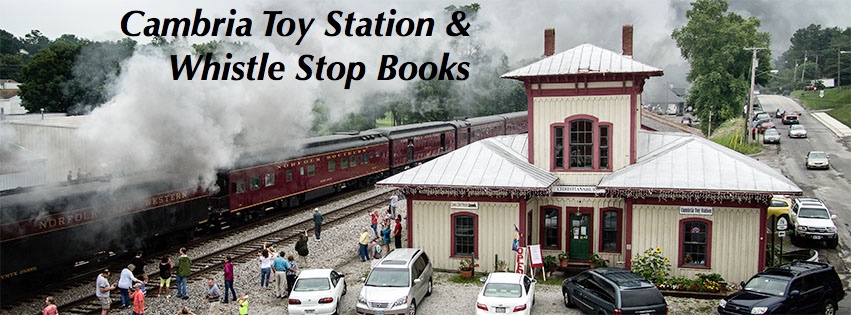Who, What, When, Where, Et Alia!
About the Owners
The Cambria Toy Station & Whistle Stop Books are owned and operated by Meghan Dorsett and Carol Lindstrom.
Meghan Dorsett. Although Meghan died on January 30, 2018, the mission here remains as her vision dictated.
Meghan, a Montana native, ended up in Giles County, Virginia in the late 1960s after her father (Jim) refused to ask directions and took a wrong turn in Cody, Wyoming. In reality, he took a teaching job at Tech and moved to Giles County because the population density was a whole lot more to his liking. Helen (his wife) was a High Plains native and likened moving to Virginia as the rough equivalent to moving to the bottom of an elevator shaft. In previous iterations, Meghan was the comprehensive planner for Montgomery County; taught writing, political rhetoric, Western American Literature, and Children’s Lit at Southwest Missouri State University; and ran a graphics company (and bartended) in Red Lodge, Montana. Along the way and following a life plan based on a greeting card on her father’s desk (Get a PhD–It Beats Working), she collected college degrees in unrelated fields in five states. When she is not in the shop or working, Meghan is passionate about Cambria, digital art and art in general, cartography, geography, writing, mysteries, history, planning, and, perhaps not surprising, politics.
Carol Lindstrom. Carol, a Louisiana native, is a freelance writer, blogger, and web designer with an avid interest in public information, FOIA, and voting rights. She is also a cancer survivor. Before moving to Virginia, Carol worked as a child abuse investigator for the State of Florida, and as a paramedic. She studied nutrition and biochemistry at Bastyr University, in Seattle (which explains why visitors to the depot are as likely to have a long discussion of food and local restaurants as a chat on the relative merits of blocks) and Human Systems Inquiry at Saybrook Institute. When she is not in the shop, Carol is in charge of the public service division of Dorsett Publications, and is a gardener (see the gardens around the depot), an avid reader (especially science fiction) and NCIS fan, and cook extraordinaire.
Exactly What is This Place?
 The Historic Cambria Depot (Christiansburg Station) was built in 1867 and opened in 1868 by the Virginia Tennessee Railroad. Because William Mahone’s wife, Ophelia, made the aesthetic decisions, the V-T built a “high architecture” depot in the middle of virtually nowhere. The practice really wasn’t that uncommon, since the railroads believed they were improving the communities they served by creating large and often fancy edifices.
The Historic Cambria Depot (Christiansburg Station) was built in 1867 and opened in 1868 by the Virginia Tennessee Railroad. Because William Mahone’s wife, Ophelia, made the aesthetic decisions, the V-T built a “high architecture” depot in the middle of virtually nowhere. The practice really wasn’t that uncommon, since the railroads believed they were improving the communities they served by creating large and often fancy edifices.
 It explains why Cambria (Christiansburg) has a Tuscan Italianate depot, the only wooden depot of its kind in the United States. (Tuscan Italianate , a residential only architecture, was “hot” between 1860 and 1875, which explains a number of things: 1) why there are very few Tuscan Italianate structures in the South; 2) why the station is oriented towards the street rather than the track; and 3) why it has eaves wide enough that you can walk around three sides of the building in pouring rain without getting wet. In 1983, the Dorsett’s purchased the depot after it was hit by a train (actually, four engines and two boxcars), an accident that left the building between 16 and 18 inches out of plumb, 12 inches off the foundation, no back wall, broken windows, and a condemnation notice on the front door.
It explains why Cambria (Christiansburg) has a Tuscan Italianate depot, the only wooden depot of its kind in the United States. (Tuscan Italianate , a residential only architecture, was “hot” between 1860 and 1875, which explains a number of things: 1) why there are very few Tuscan Italianate structures in the South; 2) why the station is oriented towards the street rather than the track; and 3) why it has eaves wide enough that you can walk around three sides of the building in pouring rain without getting wet. In 1983, the Dorsett’s purchased the depot after it was hit by a train (actually, four engines and two boxcars), an accident that left the building between 16 and 18 inches out of plumb, 12 inches off the foundation, no back wall, broken windows, and a condemnation notice on the front door.
 An excerpt from a column by Joe Kennedy (Roanoke Times, March 17, 1985) tells the story far better than can I:
An excerpt from a column by Joe Kennedy (Roanoke Times, March 17, 1985) tells the story far better than can I:
Helen [Dorsett] is saying how she and Jim stopped driving past the station because they love old structures and hated to see this one rot.
Helen would tell him that someone ought to do something to save it; would tell him so often Jim finally said “Don’t talk to me about it any more.”
Jim continues the story: “The next think I know she’s cut a deal to buy the thing. I said, “You’ve done what?”
A solid year of hard work followed. The roof and the flooring were out of line, thanks to some rampaging boxcars. The far end had begun to collapse. Inches of soot and dust filled the attic and other spaces. the building leaked, and the weather was often inclement.

Trackside Waiting Room, c. 1983. Now home to Whistle Stop Books.
The station “was an eyesore, dilapidated,” Jim says. “You have to see a thing through the eye of faith to see what it was and what it could be again.”
Infidels visited, while they labored. Two comments became common: The Dorsetts were crazy, or had money to throw away.
They can laugh about it now. They weren’t laughing then. But they’re serious about it too.
They’ve saved 4,600 square feet [actually the dimensions of the freight house, the building is 6,000 square feet], of railroad history and survived the statement of skeptics.
One day, a tall young fellow ducked in. He had a little girl, age 4, on his shoulders.
“I promised my daughter I would show her what a depot really looks like,” the man said. That convinced Jim the station was “a place that ought to exist.”

Photo Credit: Jess Anderson, c. 2011
At present, the depot houses a house, a publishing company (Dorsett Publications & The Scale Cabinetmaker), a toy store (Cambria Toy Station), and a bookstore (the newest addition, Whistle Stop Books).

Helen Dorsett in her workshop (trackside waiting room), c. 1986
The Cambria Toy Station helps cover the costs of the depot so we can keep the building, at least the front end, open to the public and so that another young man can bring in his young daughter in and say “This is what a depot really looks like.” It was a promise we made to Jim Dorsett before his death in 2005.
Whistle Stop Books, opened in October, 2015, helps raise money for ongoing preservation, including a new paint job, siding and roof repair, foundation repair (mitigating stormwater damage), and the addition of the two windows at the back of the building that were not replaced during the original restoration.
Every toy and every book that is sold helps preserve a piece of local history and helps keep it accessible to anyone who wants to visit the building just to feel history.
Spring & Summer Hours (April-August)
Please note that other hours are available if needed, just ask.
Mondays–10 a.m. to 6 p.m.
Tuesday–10 a.m. to 6 p.m.
Wednesday–10 a.m. to 6 p.m.
Thursday–10 a.m. to 6 p.m.
Friday–10 a.m. to 6 p.m.
Saturday 10 a.m. to 6 p.m.
Sundays 1 p.m. to 5 p.m.
Where
Historic Cambria:
Cambria Toy Station, Whistle Stop Books, and Dorsett Publications, LLC (The Scale Cabinetmaker)
630 Depot Street NE
Christiansburg, Virginia 24073
540.382.6431
